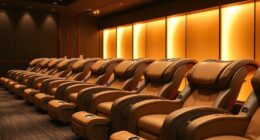If you want quick muscle relief and improved circulation, percussion therapy is a great fit for your routine, especially before or after workouts. It delivers rapid taps that loosen muscles and enhance blood flow, making it ideal for active days. If you seek long-term tissue health or treat chronic pain, myofascial release is better suited, offering gentle, sustained pressure to release fascia restrictions. To discover how to best incorporate both into your routine, keep exploring the details below.
Key Takeaways
- Percussion therapy offers quick muscle relaxation, ideal for pre- or post-workout routines, while myofascial release provides sustained, deep tissue relief for chronic issues.
- Use percussion therapy for rapid blood flow stimulation and muscle looseness; opt for myofascial release for long-term fascia health and posture improvement.
- Percussion is suitable for on-the-go, active individuals needing immediate relief; myofascial release benefits those with chronic pain or postural imbalances.
- Combining both techniques can enhance recovery and injury prevention, with percussion addressing muscle tension and myofascial release targeting fascia restrictions.
- Choose percussion therapy for quick, dynamic treatments; select myofascial release for deeper, targeted, and long-lasting tissue health benefits.

When choosing between percussion therapy and myofascial release, understanding their differences can help you make an informed decision for pain relief and muscle recovery. Both methods target muscle tension, but they do so through distinct mechanisms, offering unique massage benefits and injury prevention advantages. Percussion therapy involves rapid, repetitive taps or pulses delivered directly to the muscles via a device, often resembling a handheld massager. This approach quickly stimulates blood flow, relaxes tight muscles, and reduces soreness, making it a popular option for athletes or anyone needing quick recovery. Its massage benefits include breaking up adhesions, decreasing muscle stiffness, and enhancing flexibility, which collectively support injury prevention by maintaining healthy muscle function and reducing strain.
Percussion therapy offers quick relief by stimulating blood flow and relaxing tight muscles for injury prevention.
In contrast, myofascial release focuses on gentle, sustained pressure applied to the fascia—the connective tissue surrounding muscles. This technique aims to release restrictions and improve tissue mobility, often using hands-on techniques or specialized tools. It’s especially effective for chronic pain, postural issues, and deep-seated muscle tightness. The massage benefits of myofascial release extend beyond immediate relief; it can improve overall posture, enhance range of motion, and facilitate long-term healing. Because it targets fascia, which plays a *vital* role in muscle function and injury prevention, this method helps prevent injuries caused by restricted or imbalanced tissues. Additionally, understanding the role of fascia in muscle health can deepen your appreciation of how myofascial release promotes recovery.
Your choice depends on your specific needs and preferences. If you want a quick, dynamic treatment that can be performed on the go, percussion therapy offers immediate relief and improved circulation, making it an ideal option before or after workouts. Its ability to quickly loosen muscles helps prevent injuries related to overuse or tightness. On the other hand, if you’re dealing with chronic pain, postural issues, or deep muscle restrictions, myofascial release provides a *slower*, more targeted approach that promotes long-term tissue health. This method can be particularly beneficial if you’re recovering from an injury or aiming to prevent future problems caused by fascia restrictions.
Both techniques can complement each other when integrated into your routine, offering *extensive* benefits. Percussion therapy can prepare muscles for deeper work or activity, while myofascial release can address underlying restrictions that cause ongoing discomfort. Understanding these differences allows you to tailor your approach according to your goals, whether it’s immediate pain relief, injury prevention, or long-term muscle health. Whichever you choose, consistent application can *considerably* enhance your overall well-being and athletic performance.
Frequently Asked Questions
Can Both Therapies Be Combined Safely in a Single Routine?
You can safely combine both therapies in your routine, but it’s essential to prioritize therapy safety. Start with one method, like percussion therapy, to assess how your body responds, then gradually incorporate myofascial release. Routine integration should be gradual and mindful, ensuring you don’t overdo it. Listening to your body and consulting a professional can help create a balanced, effective approach that maximizes benefits without risking injury.
Which Therapy Offers Faster Pain Relief?
When seeking quick relief, you might find percussion therapy more responsive due to its targeted, rhythmic approach. Your instrument selection and session frequency play vital roles in how swiftly you experience benefits. Typically, percussion therapy offers faster pain alleviation because it stimulates blood flow and relaxes muscles more immediately. Adjust your routine accordingly, perhaps with more frequent sessions and the right device, to enhance and accelerate your journey toward comfort.
Are There Specific Conditions Better Suited for Percussion Therapy?
If you’re wondering whether percussion therapy suits specific conditions, the answer is yes. It’s especially effective for trigger points, helping release muscle knots and promote muscle relaxation. You’ll find percussion therapy beneficial for ongoing muscle tightness, post-workout recovery, or chronic pain. Its rapid, targeted vibrations quickly loosen tight muscles, making it ideal if you need fast relief from trigger points or want to enhance overall muscle relaxation.
How Long Should Each Session Last for Optimal Results?
For ideal results, your session duration depends on your goals and the therapy type. Typically, a percussion therapy session lasts about 1-2 minutes per muscle group, while myofascial release may take 5-10 minutes per area. You should focus on the perfect timing that feels effective without causing discomfort. Listen to your body, and adjust the session length accordingly to maximize benefits and prevent overuse or strain.
Are There Any Age Restrictions for Either Therapy?
Ever wonder if age considerations limit your options? When it comes to percussion therapy and myofascial release, safety guidelines are key. Generally, these therapies are safe for most ages, but very young children, seniors with fragile skin, or those with certain health conditions should consult a healthcare professional first. Don’t take chances—your safety depends on understanding these age restrictions to guarantee a beneficial, enjoyable experience.
Conclusion
Choosing between percussion therapy and myofascial release is like picking the right key for your body’s symphony. Both can tune your muscles and ease pain, but it depends on what resonates best with your needs. Think of percussion therapy as a powerful drumbeat that invigorates, while myofascial release feels like a gentle lullaby that soothes. Find what strikes a chord with you, and let your routine harmonize with your body’s rhythm.









